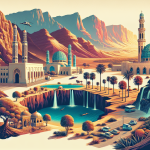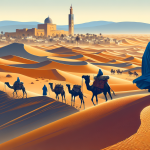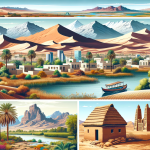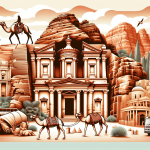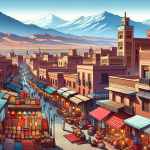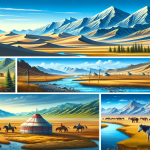Exploring the Wonders of Saudi Arabia: A Travel Guide
Saudi Arabia, a land of ancient history, rich culture, and stunning landscapes, has recently opened its doors to international tourism. As the largest country in the Middle East, it offers a variety of experiences for travelers, ranging from the bustling urban life of Riyadh to the serene beauty of the Red Sea coastline. This comprehensive guide will introduce you to the wonders of Saudi Arabia, providing insights and tips to help you plan an unforgettable trip. Whether you are interested in exploring ancient ruins, experiencing traditional Bedouin culture, or diving into crystal-clear waters, Saudi Arabia has something to offer every traveler.
Unveiling the Historical Riches
Al-Ula: The Jewel of Saudi Heritage
Nestled in the northwestern part of Saudi Arabia, **Al-Ula** is a treasure trove of history and archaeology. This ancient city, once part of the Nabatean Kingdom, is home to the UNESCO World Heritage Site of Hegra, also known as Mada’in Saleh. With its well-preserved tombs and intricate rock carvings, Hegra offers a glimpse into the lives of the Nabateans who thrived here over 2,000 years ago. When visiting Al-Ula, don’t miss the stunning Elephant Rock, a natural sandstone formation that resembles an elephant. The Al-Ula Old Town, with its narrow alleys and mud-brick houses, provides a fascinating look into the region’s past.
Diriyah: The Birthplace of the Saudi Kingdom
Located on the outskirts of Riyadh, **Diriyah** is a place of immense historical significance. It was the original home of the Saudi royal family and the first capital of the Saudi state. The well-preserved ruins of Al-Turaif District, a UNESCO World Heritage Site, offer a glimpse into the early days of the Saudi Kingdom. The area is currently undergoing extensive restoration, with plans to turn it into a major cultural and tourist destination. Visitors can explore the old palaces, mosques, and traditional Najdi architecture that define this historic site.
Embracing the Urban Experience
Riyadh: The Modern Metropolis
As the capital city, **Riyadh** is a bustling metropolis that seamlessly blends tradition with modernity. The city’s skyline is dominated by iconic landmarks such as the Kingdom Centre and the Al Faisaliah Tower. For a dose of culture, visit the National Museum, where you can learn about Saudi Arabia’s rich history and heritage. The Al Masmak Fortress, a mud-brick fort that played a crucial role in the unification of Saudi Arabia, is another must-see. Riyadh’s vibrant souks, or traditional markets, are perfect for shopping and experiencing local culture. The Deira Souk, in particular, is famous for its gold and spice markets.
Jeddah: The Gateway to the Red Sea
**Jeddah**, located on the western coast, is Saudi Arabia’s second-largest city and a major commercial hub. Known as the “Bride of the Red Sea,” Jeddah offers a unique blend of history, culture, and natural beauty. The city’s historic district, Al-Balad, is a UNESCO World Heritage Site, featuring centuries-old coral stone buildings and traditional markets. The Jeddah Corniche, a 30 km-long coastal promenade, is perfect for leisurely strolls and enjoying the sea breeze. For a taste of local cuisine, head to one of the many seafood restaurants along the coast. Jeddah is also the gateway to the Red Sea’s spectacular diving spots, making it a paradise for underwater enthusiasts.
Experiencing the Natural Beauty
The Red Sea Coast: A Diver’s Paradise
The **Red Sea** coastline of Saudi Arabia is renowned for its pristine beaches and vibrant marine life. The waters are teeming with colorful coral reefs, making it a top destination for diving and snorkeling. The city of Jeddah serves as a gateway to some of the best diving sites in the region. Further south, the Farasan Islands offer an untouched paradise for nature lovers. These islands are home to diverse wildlife, including dolphins, sea turtles, and a variety of bird species. Whether you are an experienced diver or a beginner, the Red Sea’s warm waters and stunning underwater landscapes provide an unforgettable experience.
The Empty Quarter: Exploring the Vast Desert
The **Rub’ al Khali**, or Empty Quarter, is the largest continuous sand desert in the world, covering parts of Saudi Arabia, Oman, the UAE, and Yemen. This vast expanse of golden dunes offers a unique and mesmerizing landscape. For those seeking adventure, a desert safari is a must. Experience the thrill of dune bashing, camel riding, and camping under the stars. The desert’s serene beauty and silence provide a stark contrast to the bustling cities, offering a chance to connect with nature and experience traditional Bedouin hospitality. Guided tours are available, ensuring a safe and informative journey through this awe-inspiring desert.
Engaging with Local Culture
Traditional Saudi Cuisine: A Culinary Journey
No trip to Saudi Arabia is complete without indulging in its rich and flavorful cuisine. **Saudi Arabian food** is characterized by its use of aromatic spices, rice, and meat. One of the most famous dishes is Kabsa, a fragrant rice dish cooked with meat, vegetables, and a blend of spices. Another popular dish is Mandi, which is similar to Kabsa but cooked in a tandoor oven, giving it a distinct smoky flavor. For a sweet treat, try the traditional dessert called Kunafa, made with thin noodle-like pastry soaked in sweet syrup and layered with cheese or cream. Exploring local markets and trying street food is a great way to experience the diverse flavors of Saudi cuisine.
Festivals and Events: Celebrating Saudi Heritage
Saudi Arabia hosts a variety of festivals and events throughout the year, celebrating its rich cultural heritage and traditions. One of the most significant events is the **Janadriyah Festival**, held annually near Riyadh. This cultural festival showcases traditional music, dance, crafts, and cuisine from different regions of the country. It’s a fantastic opportunity to immerse yourself in Saudi culture and learn about the kingdom’s history and traditions. Another notable event is the **Riyadh Season**, a months-long festival featuring concerts, sports events, art exhibitions, and food festivals. The festival aims to promote tourism and provide entertainment for both locals and visitors.
Practical Travel Tips
Visa and Entry Requirements
Before planning your trip to Saudi Arabia, it’s essential to check the **visa and entry requirements**. Saudi Arabia has introduced a tourist e-visa, making it easier for travelers from eligible countries to visit. The e-visa can be applied for online and is usually processed within a few days. Ensure your passport is valid for at least six months from the date of entry. It’s also important to be aware of the country’s cultural norms and dress modestly. Women are required to wear an abaya, a long black cloak, in public. While the rules have relaxed in recent years, it’s still respectful to adhere to local customs.
Best Time to Visit
The best time to visit Saudi Arabia largely depends on the region and the activities you plan to undertake. The cooler months from **November to February** are generally the most pleasant, with mild temperatures ideal for exploring cities and outdoor activities. If you’re planning to visit the desert, the winter months are preferable as the summer temperatures can be extremely high. For those interested in diving and water activities along the Red Sea coast, the spring and autumn months offer warm waters and comfortable weather. It’s important to avoid visiting during the holy month of Ramadan, as many businesses and attractions may have limited hours or be closed.
Transportation and Accommodation
Saudi Arabia has a well-developed infrastructure, making it relatively easy to travel between cities. **Domestic flights** are the quickest way to cover long distances, with major cities like Riyadh, Jeddah, and Dammam well connected. For shorter journeys, renting a car is a convenient option, and the road network is extensive and well-maintained. Public transportation options include buses and trains, with the Haramain High-Speed Railway connecting the holy cities of Mecca and Medina. When it comes to accommodation, Saudi Arabia offers a range of options, from luxury hotels to budget-friendly guesthouses. In major cities, you’ll find international hotel chains, while smaller towns and rural areas offer unique stays like traditional Bedouin tents and boutique hotels.
In conclusion, **Saudi Arabia** is a fascinating destination that offers a perfect blend of history, culture, and natural beauty. With its recent push to promote tourism, now is the ideal time to explore the wonders of this diverse and captivating country. From the ancient ruins of Al-Ula to the modern metropolis of Riyadh, the serene Red Sea coast to the vast Empty Quarter desert, Saudi Arabia promises an unforgettable travel experience. Embrace the rich culture, indulge in the flavorful cuisine, and discover the warm hospitality of the Saudi people. Plan your trip today and embark on an adventure of a lifetime in the heart of the Arabian Peninsula.
For more travel tips and destination guides, visit [Lonely Planet](https://www.lonelyplanet.com/).


